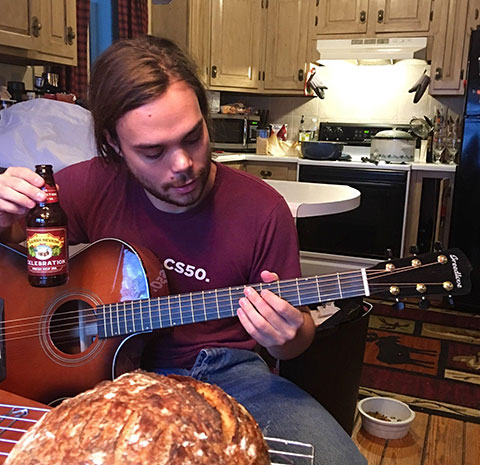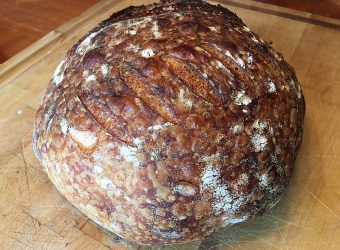 It’s just after noon, January 1, so I should probably make a New Year’s resolution right now. But screw that. I’m going to crack a cold beer, knead some bread dough and write a song, instead.
It’s just after noon, January 1, so I should probably make a New Year’s resolution right now. But screw that. I’m going to crack a cold beer, knead some bread dough and write a song, instead.
My name is Chris Arndt, and I’m honored to be Breedlove’s Featured Artist for January 2020! My sister Jocelyn and I write and play original blues-rock all over the country as Jocelyn and Chris. If you’re reading a blog on the Breedlove website, you probably already know about how they use torrefaction and deflection testing and other awesome science-fiction futuristic-type tech to make beautiful, rich sounding, über-playable guitars. You also probably know about their focus on ethically and sustainably sourcing their raw materials.
What you might not know is that they also give Featured Artists access to their blog!
So, every week between now and the end of my reign (read: February 1st), I’m going to write a blog where I pair a different guitar from one of Breedlove’s brand-new Organic Collection with a bread recipe and a beer. Because, if there’s one thing you should know about me other than my love of music and guitars, it’s my love of carbs, both liquid and loaf.
For my first week, I’m going to focusing on the Performer Concerto Bourbon CE. If you’re ever lucky enough to be a Breedlove Featured Artist, they let you pick out a guitar; this one was my pick.
The quick breakdown:
- Torrefied European spruce top
- African mahogany back, sides and neck
- African ebony fretboard and bridge
- Nice big Concerto body style
- Glossy Bourbon Burst top
- 20 frets to pluck, shred or strum your way around
I don’t know enough about different kinds of wood to tell you why this combination works so well, but I can tell you that the Breedlove luthiers knocked this thing out of the park. This guitar plays like butter and sounds unbelievably rich and full. I can’t help but grin every time I strum a chord. I think the loaf that best embodies this guitar is a naturally leavened whole wheat country boule. Classic, dark, subtle and sophisticated, this bread/guitar can hold its own in pretty much any setting, whether it be a solo feature or a supportive role.
Disclaimer: this bread takes some serious patience. Like, a few weeks of serious patience. But if you want a homemade loaf as deliciously complex and deep as the Performer Concerto, you’ve got to be willing to put in the time. And, if you do put in the time, I promise you won’t regret it. There is nothing in the world more satisfying than pulling a homemade loaf of naturally leavened bread out of the oven—except playing a Breedlove Organic Performer Concerto, of course!
To make this bread, you’re going to need:
- a Dutch oven (or other oven-safe vessel with a top large enough to bake a round loaf of bread)
- whole wheat flour
- all-purpose flour
- bread flour
- water
- salt
- some other basic kitchen tools: bowls, cheesecloth/towels, knife/bench scraper
- kitchen scale
On to the actual bread recipe! The reason this bread takes so much time is its natural leavening. Instead of using commercial bread yeast (like the kind you buy in a store), you’ll be using naturally occurring yeast. This is actually how bread was made for the entirety of human history until the late 1800s, when commercial yeast culturing became possible. To tame these natural yeasts into a usable culture, you need to make a sourdough starter.
That might sound intimidating, but it’s actually really, really easy! The natural yeast molecules are already floating around in the air; you just need to give them a home.
Take a bowl and put 200g whole wheat flour in it; now mix in 160g of lukewarm water. Put a towel over it and leave it for a day or two. Then, discard most of it (leaving around 50g) and add another 200g whole wheat flour and 160g lukewarm water, covering it once more with the towel when you’re done. Discarding part of the starter and adding more flour and water is called ‘feeding’ the starter; it gives the yeast culture more sugars to eat so they don’t starve. After a few feedings (it took me seven days of daily feedings), your starter should begin to bubble and smell vinegary and sour. The bubbles are CO2 and the aroma is the chemical byproduct of the natural yeast. Congratulations! You’ve made a sourdough starter!
At this point, you’ve got an active culture, and you need to start training it. Yeast does different things to bread dough under different conditions; you can change the temperature, hydration level and feeding schedule to control how your bread ends up tasting. For this recipe, you should train the starter for at least four days to make sure the yeast are doing what you want them to do. During the training period, you should feed your starter once every 24 hours with 50g whole wheat flour, 200g all-purpose white flour and 200g lukewarm water. The ambient temperature of your kitchen should be fine.
Now, you’re finally ready to make some bread dough! Mix 250g of bread flour, 150g whole wheat flour and 35g all purpose flour in a large bowl; mix in 305g of lukewarm water with your hands. Wait an hour for the flour to absorb the water, and then mix in 105g of your starter, 11g of salt and another 15g of lukewarm water. Make sure all the ingredients are fully incorporated and then fold the dough over itself a few times. Now it’s a waiting game; the dough should roughly double in size over the next 6-12 hours (if you have a hot kitchen, it’ll be more like six; if it’s chilly, plan to wait a while). During the first three hours of that time, fold the dough over itself and flip it over so the seam is on the bottom, every 30 minutes. This folding process is a replacement for the kneading that most bread doughs require. Then, just let it sit.
Once the dough has doubled in size, dump it out on a floured surface. Find a bowl around 9” in diameter, place a towel in it and flour the towel. Now you’ve got to shape the loaf. Stretch out the bottom of the bread dough and fold it over the middle. Do the same with the right, top and left, and then sprinkle a little flour over the top, where the seam is. Flip the dough ball over, cup your hands around the back of it, and tug it towards you on the countertop; this builds tension in the gluten on the outside of the loaf so that it stays in shape when you bake it. Finally, place it seam-side up in the prepared bowl.
Three hours after shaping, preheat your oven to 480F and place your empty Dutch oven or other baking vessel in it. An hour later, remove the hot, empty vessel from the oven and place it on a trivet. Now, invert the bowl of dough onto a sheet of parchment paper, score it in a pretty pattern using the knife, and drop it, still in the parchment paper, into the vessel. Don’t burn your hands; that thing is almost 500 degrees! Cover it with the top and place it in the oven. 30 minutes later, remove the top and bake for another 15–20 minutes until the loaf has your desired color. I like mine pretty dark, like the color of a Breedlove Legacy. Let the bread cool for an hour or two, and it’s finally ready!
The best beer pairing for this bread/guitar combo is definitely Sierra Nevada Celebration Fresh Hop IPA. It’s got enough body to handle the nuttiness of the whole wheat in the bread, enough hops to stand up to the loaf’s sour notes and it’s delicious enough to drink while playing the Performer Concerto without feeling bad about it. Plus, it’s only on the shelves during winter. Carpe diem, or maybe carpe beer. I don’t speak Latin.
So that’s it for this week! Make great bread, drink great beer and play great music on a great Performer Concerto. I know this recipe is a pretty big commitment, but an instrument this grand calls for an exceptional bread. Check out my featured artist page for more info on who I am as a musician, and tune in next week for a new beer/bread/Breedlove pairing!




